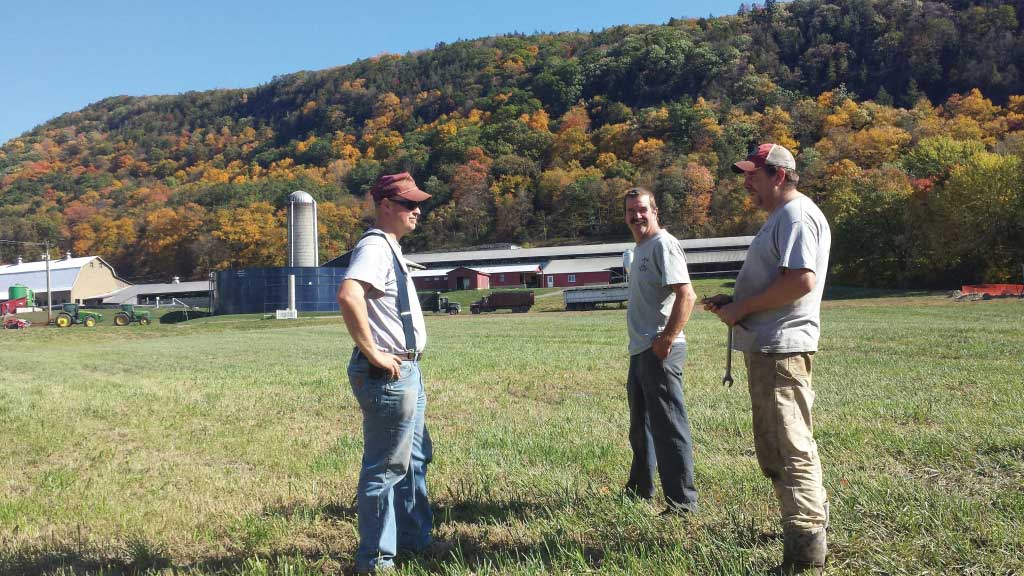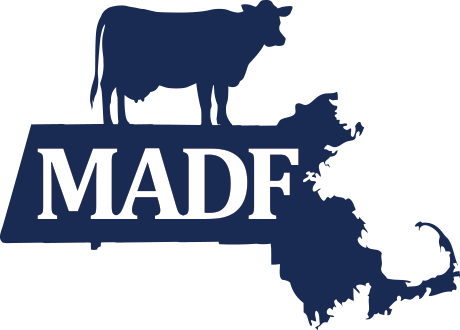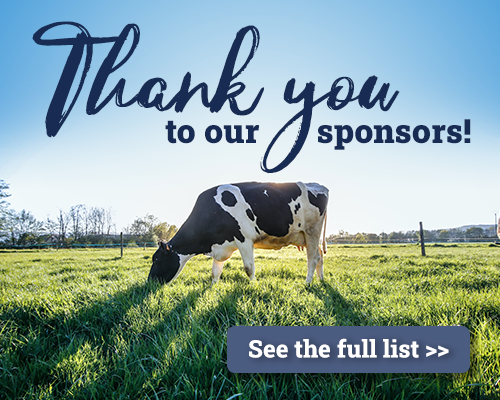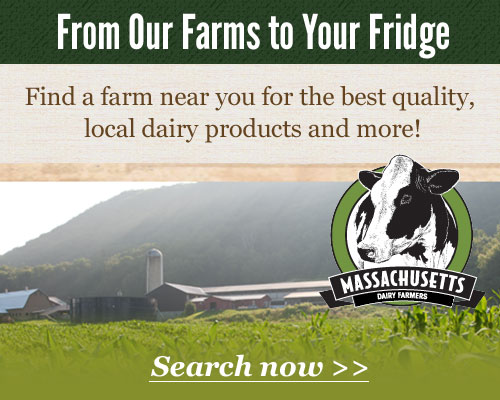Got robots?
Dairy farmers use technology to eke out a living.
Sixth-generation family farmers Dave and Steve Barstow have stretched the limits of what dairy farmers can do to stay afloat. They opened a store and bakery on their dairy farm at the foot of Mt. Holyoke in Hadley. They generate electricity from composted cow manure and food scraps. They even market a line of farm equipment. But low milk prices have kept their bottom line in the red. So, a couple of years ago, they sold the development rights to their land to the state and invested the proceeds in robots that milk the cows.
“We knew we either had to go out of business or put in the robots,” says Dave Barstow. “The next generation wanted to keep farming, so we put in the robots.”
Steve Barstow’s son, who is also named Steve, is the next generation. He is in the process of taking over management of the farm from his father and uncle, and he says the robots have cut labor and feed costs while increasing milk production. Depressed milk prices are still making it impossible to turn a profit, but Barstow says the farm would have gone under without the robots.

At the foot of Mt. Holyoke in Hadley, the sign out front says Barstow’s Longview Farm: Looking forward since 1806. From left, Rob Adair, a private contractor (excavator) working at the farm, Dave Barstow, and Steve Barstow II.
Robots are a way for New England dairy farmers milking a few hundred cows to compete in the global milk market against giant farms in the Midwest milking tens of thousands of cows. A handful of farms in Massachusetts have purchased the technology, and many more desperately want it. A robotic milking system doesn’t completely level the playing field with bigger farms, but it helps in a variety of ways.
Robots boost production by milking cows whenever they feel full. “The more you take the more she makes” is an old dairy farm saying which holds true whether the cow is milked by a human or a robot. But the robot operates 24-7, so cows no longer have to wait on the farmer to milk them, which on most farms is twice a day. The Barstows’ cows are now milked an average of almost three times a day, increasing production by nearly 20 percent.
“People hear about the robots and they think they’re chasing the cows around to milk them,” says Dave Barstow. The reality is that cows frequently stand in line behind their herd mates, waiting to visit the robot. The attraction is two-fold: cows offload their milk and also feed on grain while they are milked.
The robots use sensors to identify electronic tags on each cow to make sure no one cow is visiting the milking station too often. Conversely, if too much time passes before a cow shows up in line, the robot sends an alert to the farmer to check on her.
The robots also track a cow’s milk production and tailor feed rations to each animal’s dietary needs. Cows that produce more milk get larger rations with higher protein. “That way, we don’t overfeed the cows that aren’t producing as much, and give the higher producing animals what they need,” says Dave Barstow.
The robots don’t look like much. They are basically a piece of machinery on an arm that slides underneath the cow after it enters the milking area. The robot uses lasers to detect where the cow’s teats are located and then thoroughly cleans them. The scan process is repeated, rubber suction devices are inserted over the cow’s teats, and the milking process begins.

The milking robot prepares to attach itself to a cow’s teats.
It’s hard to beat the consistency and efficiency of a robot when it comes to the cleaning and general care of a cow’s teats. Farms using the technology invariably have lower bacteria counts in milk and fewer cases of mastitis and other udder health problems.
The Barstows used to spend 10 hours a day milking their cows and paid part-time workers to help with the evening milking shift. Now they spend a little time each day making sure the robots are operating efficiently and focus the rest of their attention on other farm chores.
All these advantages might suggest a turnaround in the Barstows’ profit margin, but that hasn’t happened yet. Shortly after installing the new system at Longview Farm in 2014, the wholesale market for milk collapsed. Milk prices were significantly below the cost of production in Massachusetts last year and are expected to be roughly the same this year, according to UMass resource economist Daniel Lass. After getting $26 for every 100 pounds of milk a couple years ago, farmers are now receiving about $17 for the same amount, about 40 percent below their $29 cost of production.
In a report, Lass noted that many farmers, like the Barstows, bring in extra cash through other endeavors, easing the pain of low milk prices. When income and expenses from these other sources were factored in, however, he calculated that total dairy farm revenue was still on average almost 25 percent below the cost of production.
“New England farmers are very adaptable, but month after month of sustained low milk prices is just brutal,” says Mark Duffy, manager at Great Brooks Farm in Carlisle, which five years ago became the first farm in Massachusetts to install robots.
For now, the Barstows are resigned to keeping their operation afloat until the price of milk improves. “We work for the bank around here. The bank makes more money than we do,” says Dave Barstow. “I don’t want to be a rich guy, I just want to get a fair, living wage.”
While his farm may fall short as a living, Dave Barstow says, it’s also a lot more than that. “It’s a lifestyle and a way of life. I don’t know any other way of life, but I know it’s been a great place to raise my kids, and my kids, who are now in college, concur,” he says.
As an early adopter, Duffy is a big believer in robots as a way to keep dairy farms in business, but he says they also dramatically improve a farmer’s quality of life.
“The robots are a game changer,” he says, “Instead of coming down to the barn at six because that’s the time you always milk, you come down a little later and go see your kid’s ball game at six.”
Robots also may help make farms more sustainable by engaging farmers who have been raised in the digital age. “The next generation loves them,” says Duffy, “That’s what it’s all about, getting our farms to the point where the next generation not just can, but wants to take them over.”
Duffy says a lot of farms are eager to purchase the robots right now, but can’t due to the slumping milk market. A farm needs to install roughly one robot for every 60 milk cows. Each robot costs $140,000. The Barstows have four robots for their herd of 240 cows, or a total investment approaching $600,000—not a minor expense for farm operations on the edge of survival. New England dairy farmers have little control over milk prices, which are calculated by the US government in response to global market forces.
Duffy says milk prices in the US are depressed because demand is low due to China’s reduced imports of dry milk and Russia’s embargo on US and European milk. There is also a glut of milk on the world market, partly because European countries are allowing their farmers to produce more milk and partly because states in the Midwest are boosting production.
This year’s historic drought accentuated the challenges facing dairy farmers. Duffy says the lack of rainfall meant the region’s farmers were not able to make as much feed for their animals. Low milk prices, however, made it prohibitive to buy food to replace what farmers couldn’t grow on the farm. “I can’t remember any time we’ve had anything like this,” he says of the drought conditions in New England.
Bob Wellington, a dairy economist for Agri-Mark, a cooperative buying milk from dairy farmers throughout New England and New York, says the region lost about 50 farms over the past year due to low milk prices and drought, leaving just 1,200 in the region and 140 in Massachusetts. “We have serious concerns about the next 12 months as farmers go into a third consecutive year of farm milk prices well below their cost of production,” he says.
State Rep. Stephen Kulik of Worthington says dairy farms benefit everyone in the Commonwealth, not just those who live on or near them. “They keep land open, which is good for the economy, the environment, and the aquifers,” he says, “And they provide a fresh, local supply of milk. The growth of a robust locavore movement here shows that our citizens want and support local food.”
Kulik was instrumental in setting up a state tax credit that protects Massachusetts farmers from going out of business when milk prices fall below the cost of production. Lass’s study was originally commissioned to determine that trigger point.
“Farmers tell me that the tax credit has been a godsend in that it has kept their heads above water,” says Kulik, “but the pricing situation right now is very dire.” Last year, he says, he was unsuccessful in raising the $4 million cap on the tax credit program.
“We are not looking for a handout,” says Duffy, “We know the Commonwealth didn’t have the expected revenue last year, but if we can get the cap of the program up to $6 million per year, that would really help dairy farms stay in business.”
Source: CommonWealth









